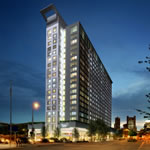Boston-based real estate developer The Drew Company has a long history of incorporating sustainability into its diverse portfolio. But in the past five years, the company has made an even bigger push to require LEED certification on all its projects. Drew Company’s tagline is “vision, quality, and results,” and the new Waterside Place, a 350,000-square-foot, mixed-use project in Boston’s booming Innovation District, exemplifies many of the firm’s best practices.
The Innovation District is known for its recent influx of young, creative professionals running small startups, and it’s often described as a newly burgeoning area, but the Drew Company recognized the area’s potential before it became Boston’s next “it” neighborhood. Sometimes referred to as the Seaport District, it was an industrial area comprising little more than a series of mostly unused parking lots. When a highway interchange was constructed in the 1990s, it put the Seaport District in close proximity to downtown and enabled drivers to avoid the downtown traffic. Allen says this is one of the major factors that put the area on the map, and it became a selling point for the Drew Company when it began to market the Seaport Hotel, a joint venture between the firm and Fidelity Investments, as one of the first new buildings to be erected in the area.
In March 2003, when the Drew Company won a competition for the development of Waterside Place, the project was envisioned as a large, 1.2 million-square-foot, mixed-use project encompassing a hotel, residential condominiums, an urban retail mall, and more than 2,000 parking spaces. The initial project was located on an eight-acre site and had a $700 million budget.
“We’re very excited by what’s happening in the area, and we feel like the timing for the Waterside Place project is right for this part of the city.”
Susan Allen, The Drew Company
In response to the economic recession, the Drew Company decided to make major revisions to its original plan. Waterside Place was adjusted to have 236 residential rental units, 10,000 square feet of retail space, and 6,500 square feet of “innovation space.” “We ran into the same problems that many firms experienced during this time,” says Susan Allen, the Drew Company’s executive vice president. “Plans had to be revised and then revised again—and then for a while, construction ceased. We stepped back and replanned the entire project, developing it for the newly defined market. We’re very excited by what’s happening in the area, and we feel like the timing for the Waterside Place project is right for this part of the city.”
Moving forward with a budget of approximately $120 million and downsizing to two acres, Waterside Place broke ground in mid-2012 with planned final completion set for April 2014. The building’s first units will begin leasing in January 2014 and despite having to scale back considerably, Waterside Place will exemplify the latest in luxury residential living while also featuring the best of what sustainable design has to offer.
Hank Suominen, a senior project manager at Commercial Construction Consulting, is the project manager for design and construction for Waterside Place and says that green building is about more than efficiency—it’s also about human health. “Everything about this project, from design to construction, lends itself to health and wellness,” he says. Suominen is particularly proud of the owner’s decision to proceed with a no-smoking policy, which goes well beyond prohibiting tenants from smoking in the building. From the earliest stages of building, construction workers weren’t allowed to smoke on-site or near the building materials.
“If you look at aerial photographs of the area from 20 years ago, it was industrialized blight,” Suominen says. “What it’s becoming is amazing. It’s in proximity to public transportation. It’s a great urban environment for city dwellers who want to lower their carbon footprint and who don’t have the throw-away mind-set we’ve become accustomed to. The project will have the usual green features, like Energy Star appliances, low-VOC paints, and sustainable building materials such as concrete and structural steel, but we’re also pushing for more. There will be charging stations, and we’ll offer parking location preference for fuel-efficient vehicles. We want to take green in a different, more comprehensive direction.”

